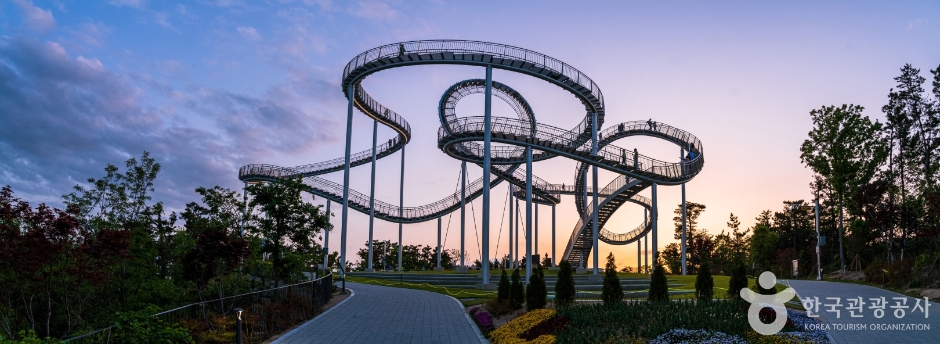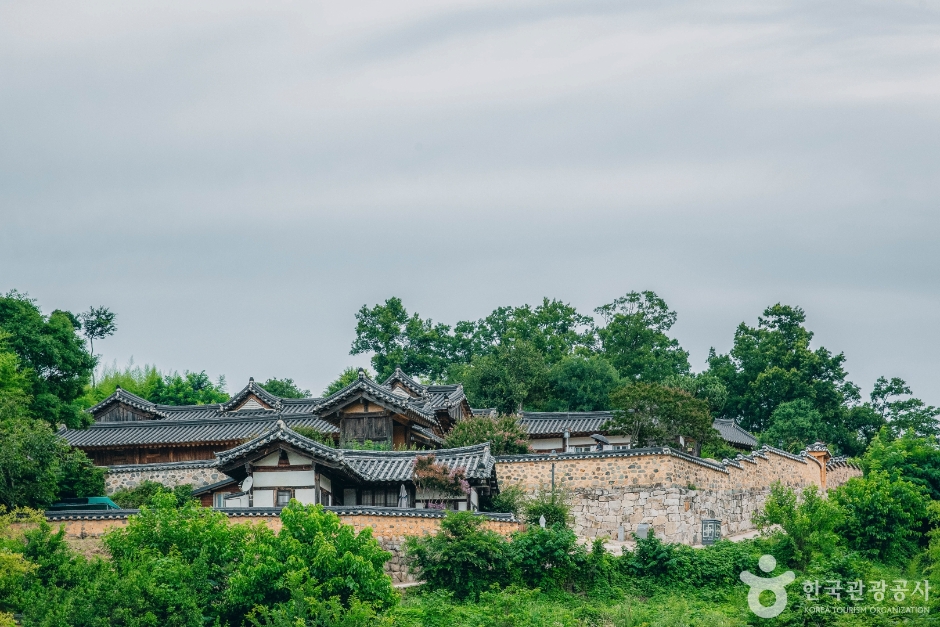Hwanho Park (환호공원)
5.3Km 34333 2024-02-13
347 Hwanho-dong, Buk-gu, Pohang-si, Gyeongsangbuk-do
Hwanho Park stands as Pohang's largest park, situated just behind Yeongildae Beach. This expansive park seamlessly blends the beauty of nature with modern amenities. It offers a wide array of attractions, including a children's playground, the Pohang Museum of Steel Art, charming fountains, a dedicated library for children, and an outdoor stage for various events and performances. Notably, Hwanho Park provides visitors with the opportunity to enjoy breathtaking views of Pohang Steel and the vast expanse of the sea, as well as a unique space walk that evokes a sense of walking in space. Nearby, you'll find additional attractions like the Yeongildae Observatory and the Pohang Marine Park Character Theme Park.
Space Walk (스페이스워크)
5.3Km 0 2024-10-04
30 Hwanhogongwon-gil, Buk-gu, Pohang-si, Gyeongsangbuk-do
+82-54-270-5176
Space Walk is a unique track 333 meters high with 717 steps in total. The curved steel frame with bright lightings portray the symbol of Pohang "the city of steel and light." Visitors can enjoy a panoramic view of the city and factories, as well as enjoy amazing sunsets and sunrises.
Olive Young - Pohang Jangseong Branch [Tax Refund Shop] (올리브영 포항장성점)
5.8Km 0 2024-06-26
1267, Saecheonnyeon-daero, Buk-gu, Pohang-si, Gyeongsangbuk-do
-
Olive Young - Pohang Yangdeok Branch [Tax Refund Shop] (올리브영 포항양덕점)
7.2Km 0 2024-06-27
225, Sindeok-ro, Buk-gu, Pohang-si, Gyeongsangbuk-do
-
Yeongil Bay Hot Springs (영일만온천)
8.0Km 22503 2020-03-18
21, Unje-ro 386beon-gil, Nam-gu, Pohang-si, Gyeongsangbuk-do
+82-54-285-0101
The construction of this huge hot spring complex started in Yeongil Bay in 1988 after it was found that Yeongil Bay has the highest geothermal heat in Korea while drilling for oil in 1974.
The water’s main ingredients contain healthy minerals such as calcium, natrium, fluorine, magnesium, chlorine, sulfuric acid, fluorine, zinc, germanium and radium. Yeongil Bay Hot Springs maintains its water with alkali bicarbonate at a pH of 9.43. The temperature of the water is somewhat low though at 35℃.
The hot springs help to recover from fatigue, to help beauty care, anti-aging, neuralgia, heart disease, and liver functions. The water here also has a very unique texture.
Homibando Peninsula Coastal Trail (호미반도 해안둘레길)
10.1Km 0 2024-02-13
360 Ibam-ri, Donghae-myeon, Nam-gu, Pohang-si, Gyeongsangbuk-do
The Homibando Peninsula Coastal Trail is a picturesque trekking route that spans a remarkable 58 kilometers of Pohang's coastline, stretching from Donghae-myeon to Janggi-myeon via Guryongpo-eup and Homigot Cape. This easternmost section of the Korean Peninsula offers an opportunity to marvel at rugged cliffs and savor the soothing sounds of crashing waves as you stroll along the shoreline. The trail is divided into four distinct courses, with the third course, known as Guryongso-gil, being the lengthiest, taking approximately two hours to complete. It begins at Janggun Rock, winding its way through the Golden Rain Tree and Black Jetbead colonies, ultimately concluding at Guryongso. On the other hand, the fourth course, Homi-gil, is the shortest and starts at Eagle Rock, concluding at the picturesque Homigot Sunrise Square.
Hyangdan (향단)
10.6Km 42643 2024-08-05
121-83 , Yangdongmaeul-gil, Gyeongju-si, Gyeongsangbuk-do
+82-10-6689-3575
Hyangdan in Yangdong Village, Gyeongju, Gyeongsangbuk-do, is a grand old house designated as a national treasure, having been built by King Jungjong for the elderly mother of his courtier Yi Eonjeok. Much of the original 99-kan house was destroyed during the Korean War and the rest converted to a guesthouse. Visitors can stay in the anchae, haengnangchae and an annexe - which all appear to be different x_heights because of the upward slope of the site. Various experience programs are offered: woodblock printing, a tea ceremony, natural dyeing, and traditional etiquette.
Gyeongju Yangdong Village [UNESCO World Heritage] (경주 양동마을 [유네스코 세계문화유산])
10.7Km 87902 2022-11-08
134 , Yangdongmaeul-gil, Gyeongju-si, Gyeongsangbuk-do
+82-54-762-2630
Gyeongju Yangdong Village is Korea’s largest traditional village, showcasing the traditional culture of the Joseon dynasty and the beautiful natural surroundings. Thanks to its many cultural heritages, including treasures, national treasures, and folklore materials, the entire village has been designated as a cultural heritage site. Many people have visited this village to see its wealth of cultural heritages and scenic surroundings, including King Charles III, who visited this village in 1993.
Seolchangsan Mountain and its four spines of mountains can be seen beyond the village. Approximately 160 old houses and 500-year-old thatched-roof cottages are nestled within the valley. Fifty-four of these homes are over 200 years old and have been excellently preserved in their original state, offering the opportunity to view a variety of unique traditional Korean houses in person.
Oeosa Temple (오어사(포항))
10.9Km 38520 2023-01-25
1 , Oeo-ro, Nam-gu, Pohang-si, Gyeongsangbuk-do
+82-54-292-2083
Oeosa Temple in Unjesan Mountain is a place where the deep scent of Buddha can be felt with a lake that looks like a dragon wrapped around it and the strangely-shaped cliffs which harmonizes like an oriental painting. Oeosa Temple is a sacred place where the four great patriarchs of Silla were born. This temple was built during the reign of King Jinpyeong (579-632), the 26th ruler of Silla. It was originally called Hangsasa Temple, but when Great Master Wonhyo and Zen Master Hyegong practiced religious asceticism here, a contest was held to revive the fish in the stream with religious power. However, one of them did not survive, and the other did and swam vigorously.
So each argued that he himself saved the fish, so they called it Oeosa Temple by writing the characters 'O' and 'Eo.' Daeungjeon Hall has a hip-and-gable roof with three bays in the front and two in the side. It was rebuilt in the 17th year of King Yeongjo of the Joseon dynasty (1741). Around the temple, the beautiful natural scenery of Unjesan Mountain and the blue water of Oeoji are spectacular. Jajangam Hermitage can be seen on the rocky cliff, and Wonhyoam Hermitage can be seen to the west of Oeosa Temple. Daeungjeon Hall (Gyeongbuk cultural heritage) has a national treasure bell, Buddhist monk Wonhyo's hat, and many other relics.
Chilpo Beach (칠포해수욕장)
12.3Km 58650 2024-02-13
Heunghae-eup, Buk-gu, Pohang-si, Gyeongsangbuk-do
Chilpo Beach is celebrated for its four kilometers of white sand and crystal-clear waters. The shallow waters near the beach, approximately one meter deep, are ideal for children, while further out, the depth reaches adult shoulder level, making it suitable for swimmers of all ages. Additionally, visitors can enjoy a scenic trek along the wooden deck at the beach's end, offering splendid views of the East Sea. Since 2007, the beach has become even more renowned for hosting the Chilpo Jazz Festival every September. This event presents a unique opportunity to experience live jazz music by the sea, adding a musical charm to the autumn ambiance.



![Gyeongju Yangdong Village [UNESCO World Heritage] (경주 양동마을 [유네스코 세계문화유산])](http://tong.visitkorea.or.kr/cms/resource/44/2654744_image2_1.jpg)
 English
English
 한국어
한국어 日本語
日本語 中文(简体)
中文(简体) Deutsch
Deutsch Français
Français Español
Español Русский
Русский